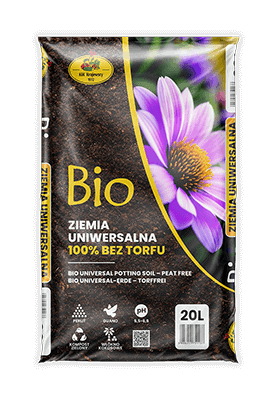



• House plants – perfect substrate for most plants grown at home.
• Vegetable gardens – ideal for establishing vegetable gardens.
• Pots and hanging baskets – excellent for transplanting plants into pots and hanging baskets.
• Balcony flowers – suitable for growing flowers on balconies.
• Trees and bushes – suitable for transplanting trees and bushes.
• Improving soil structure – may be used for improving the structure of light and heavy soils.
• Composted bark
• Green compost
• Wood fiber
• Coconut fiber
• Perlite
• Guano
• BIO plant-based fertilizer
• pH: 5,8–6,8
• Salinity: 0,5-2,5 g NaCl/dm3
• Texture: 0–40 mm
• Best period to transplant: It is recommended to transplant plants in spring.
• Preparation of the product: The product is pressed mechanically. Before use, it is recommended to loosen it. The dry soil should be moisten with water.
• Transplanting into pots: Prepare a clean pot with drainage holes larger than the root system. Carefully take the root system out and remove the dead roots. Pour a drainage layer, e.g. expanded clay, into the pot. Put the plant into the pot at the appropriate depth and fill the pot with the soil up to 2 cm below the edge. Press the soil and water the plant moderately.
• Transplanting trees and bushes: Dig a hole which is about 30% larger than the root system. Fill it partially with our soil. Put the plant into the hole at the appropriate depth and fill the hole with the substrate.
• Planting ground plants/vegetables: Spread the soil at the depth of about 15–30 cm and then plant the plants. Water them moderately immediately after planting.
• We recommend to start fertilizing 6–8 weeks after transplanting.